Sinkholes
Sinkholes vary in size and severity. They can range from a few feet to hundreds of acres wide and from inches to hundreds of feet deep. And they can be an unnoticable terrain feature or an immediate, unexpected emergency.
What is a Sinkhole?
A sinkhole is an area of land surface that has collapsed into an underground cavity. These cavities are created by bedrock - typically limestone, carbonate rock, and salt beds - that naturally dissolves in the groundwater circulating through it.
Sinkholes can occur naturally as an act of God or by human endeavors, such as construction and development. Some water-diversion practices - industrial and runoff-storage ponds, irrigation systems, etc. - can also lead to sinkholes.
Not all sinkholes make the 6 o'clock news. Most sinkholes form so slowly they're almost unnoticable. It's when a cavity is so large a collapse forms suddenly that sinkholes can cause fast, unexpected, catastrophic damage.
Any sinkhole - even an expected sinkhole - should be inspected by an expert. A sinkhole repair service may offer excavating services, bedrock and land surface repair, as well as repair services to systems effected by a sinkhole - such as plumbing, electrical, and construction.
Types of Sinkholes
There are three main types of sinkholes: dissolution sinkholes, cover-subsidence sinkholes, and cover-collapse sinkholes.
The common characteristic of all sinkholes is that the bedrock erodes and is filled in with the land surface (or the sediments is contains) - be it sand, dirt, or clay - until a land depression is formed or a collapse occurs.
Dissolution Sinkholes
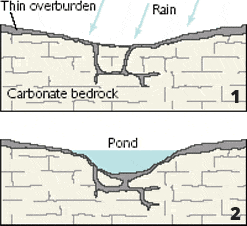
With a dissolution sinkhole, the majority of errosion happens where water first contacts the bedrock - closer to the surface.
They occur more quickly when errosion is increased by preexisting openings, joints, fractures, and bedding planes in the bedrock.
In most cases, rainfall and surface water pass through spaces in the bedrock, causing errosion. The dissolved bedrock is carried away and a small depression slowly occurs.
With exposed bedrock, a depression holding surface water will likely accerlate further errosion to the point that outflow is plugged and ponds or wetlands are created.
Cover-Subsidence Sinkholes
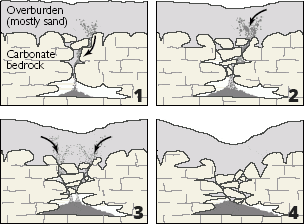
Cover-subsidence sinkholes typically involve a land surface of permeable sediments, such as sand. Cover-subsidence sinkholes are much less common, smaller, and go unnoticed for long periods of time when land surface contains impermeable sediments, such as clay.
With cover-subsidence sinkholes sediments, mostly sand, slowly settle in open spaces of bedrock until eventually a noticable depression is present on the land surface.
Cover-Collapse Sinkholes
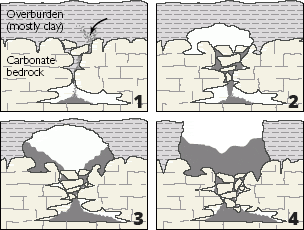
Cover-collapse sinkholes can be abrupt and cause catastrophic damage. They typically involve a land surface of impermeable sediments, such as clay.
The land surface is impermeable enough that it holds while bedrock errosion continues to increase the size of the underground cavity and a structural arch is formed. When the cavity reaches the point that the arch can no longer provide support, a sinkhole occurs.
Cover-collapse sinkholes can happen very fast, sometimes within hours.
Sinkhole Detection How Do I Know if I Have a Sinkhole?
Currently, there isn't an effective system to detect sinkholes on properties. However, there are a variety of symptoms of sinkholes that homeowners can watch for.
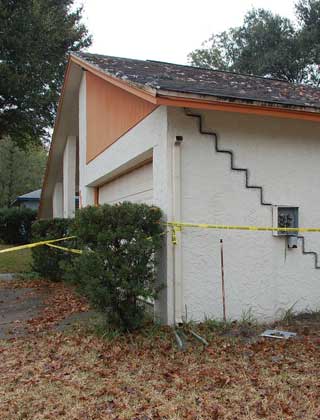
Aside from knowing the geological composition of your region and likelihood for sinkhole events (check out the next section), you can and should be on the look out for:
Sinkhole Warning Signs
- Small holes in the ground
- Cracks in foundations
- Cracks in exterior blocks
- Cracks in exterior stucco
- Joint area cracks
- Offset windows and doors
- Cracks in windows and doors
- Depressions in your yard
- Depressions on your street or nearby properties
- Deep cracks and separation in driveways and walkways
- Confirmed sinkholes nearby
Where Do Sinkholes Happen?
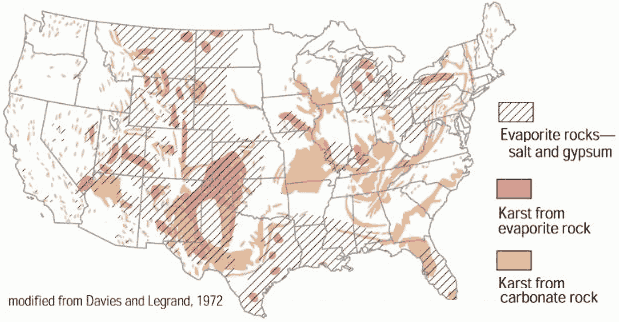 For a more detailed map including sinkhole potential, Click Here.
For a more detailed map including sinkhole potential, Click Here.
Sinkholes can occur where bedrock consists of certain rock types: evaporites (salt, gypsum, and anhydrite) and carbonates (limestone and dolomite). About 35-40% of the United States consists of bedrock susceptible to sinkholes, however in many areas it is at great depths. About 20% of the USA is underlain by bedrock susceptible to sinkholes.
For more information on sinkhole probability in your neighborhood check with your county offices, local and state geological surveys, and the USGS.
Sinkhole Damage
The states with the greatest amount of damage caused by sinkholes, include:
- Florida
- Texas
- Alabama
- Missouri
- Kentucky
- Tennessee
- Pennsylvania








